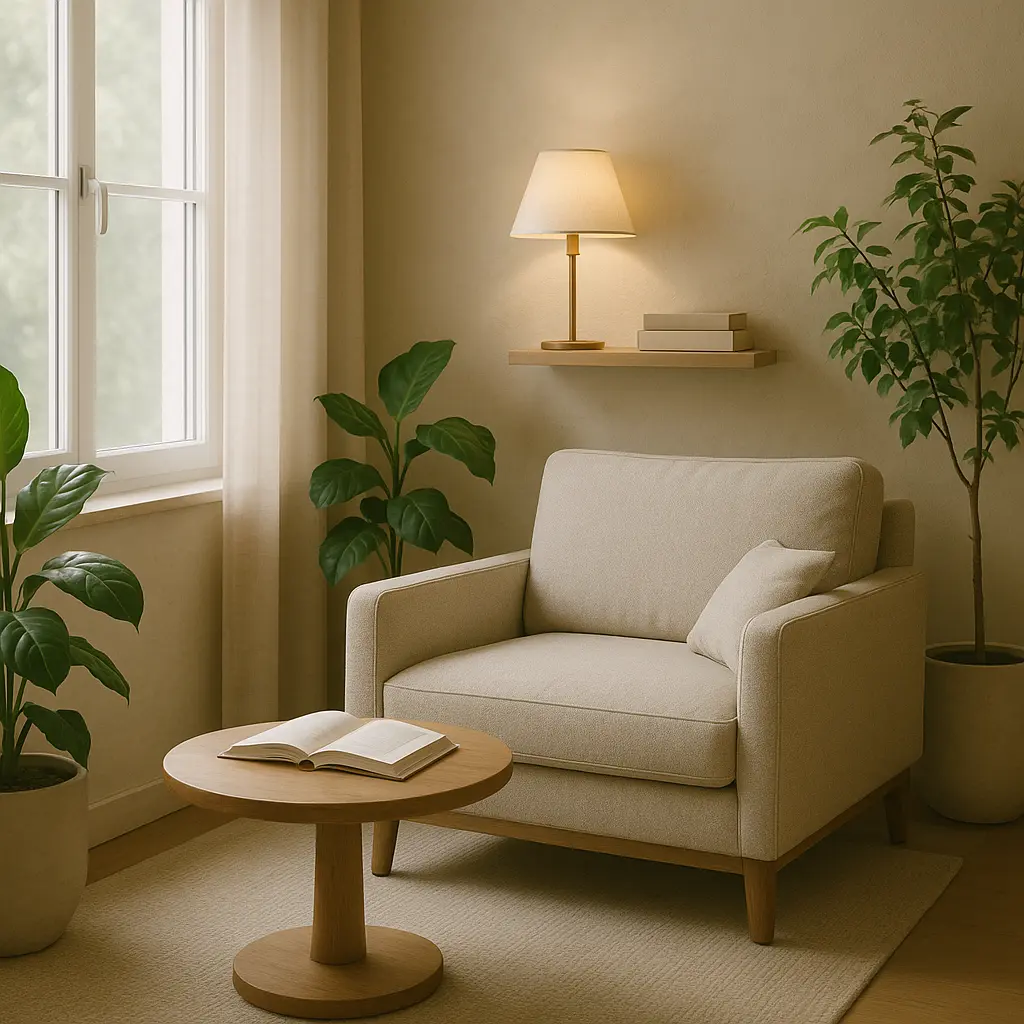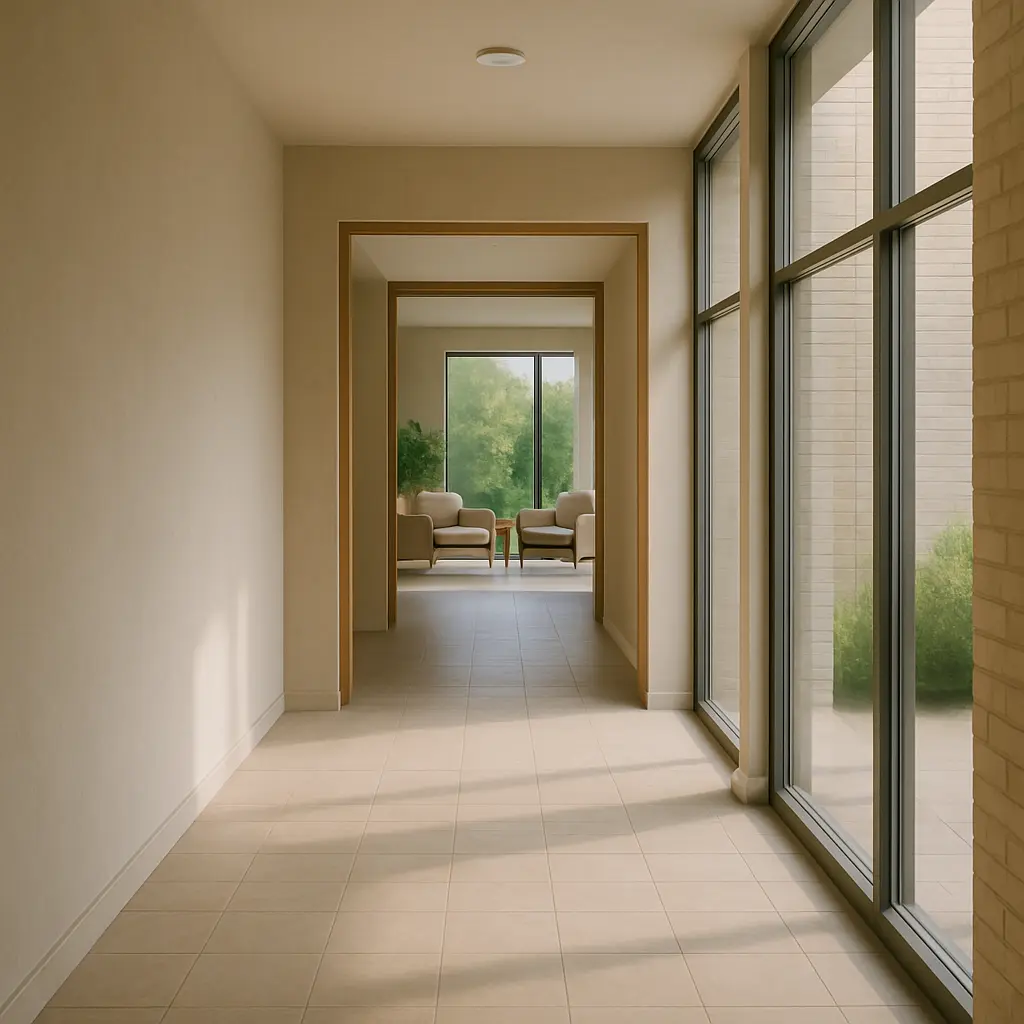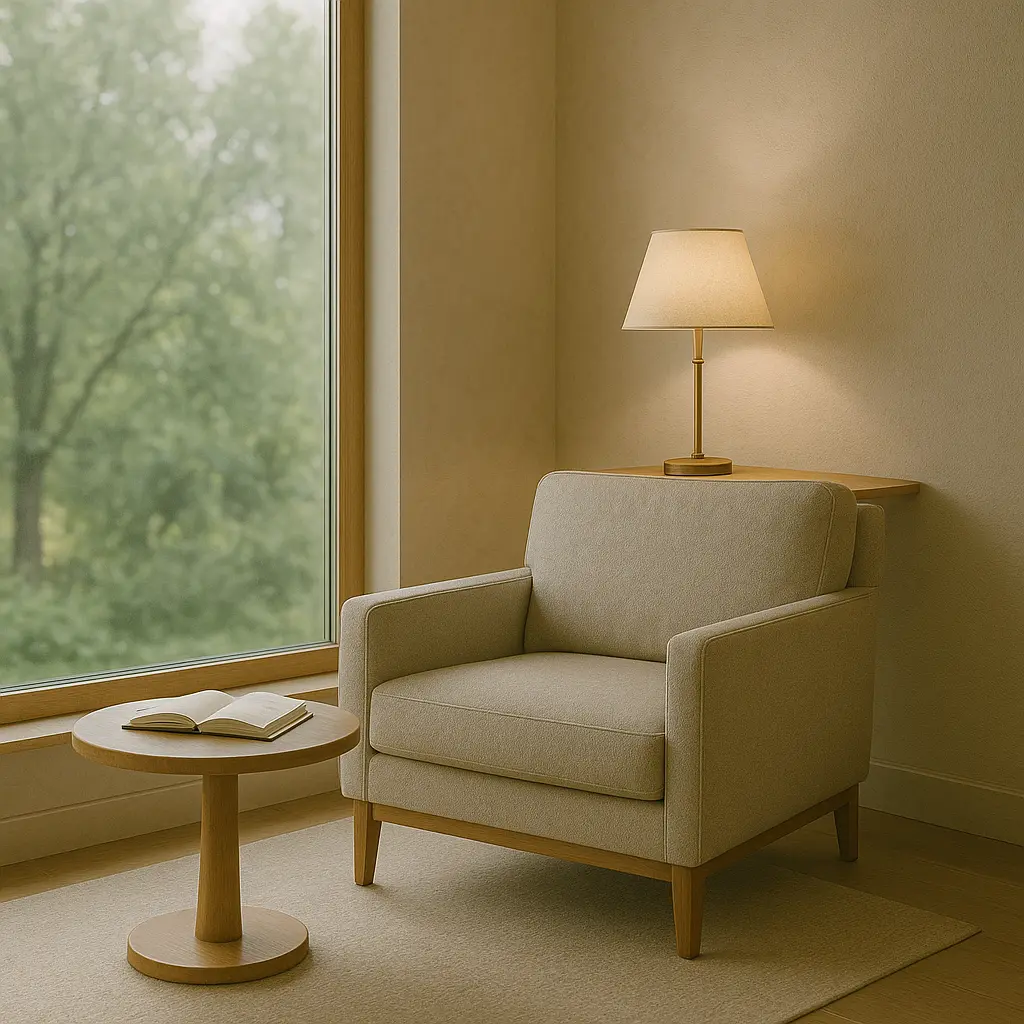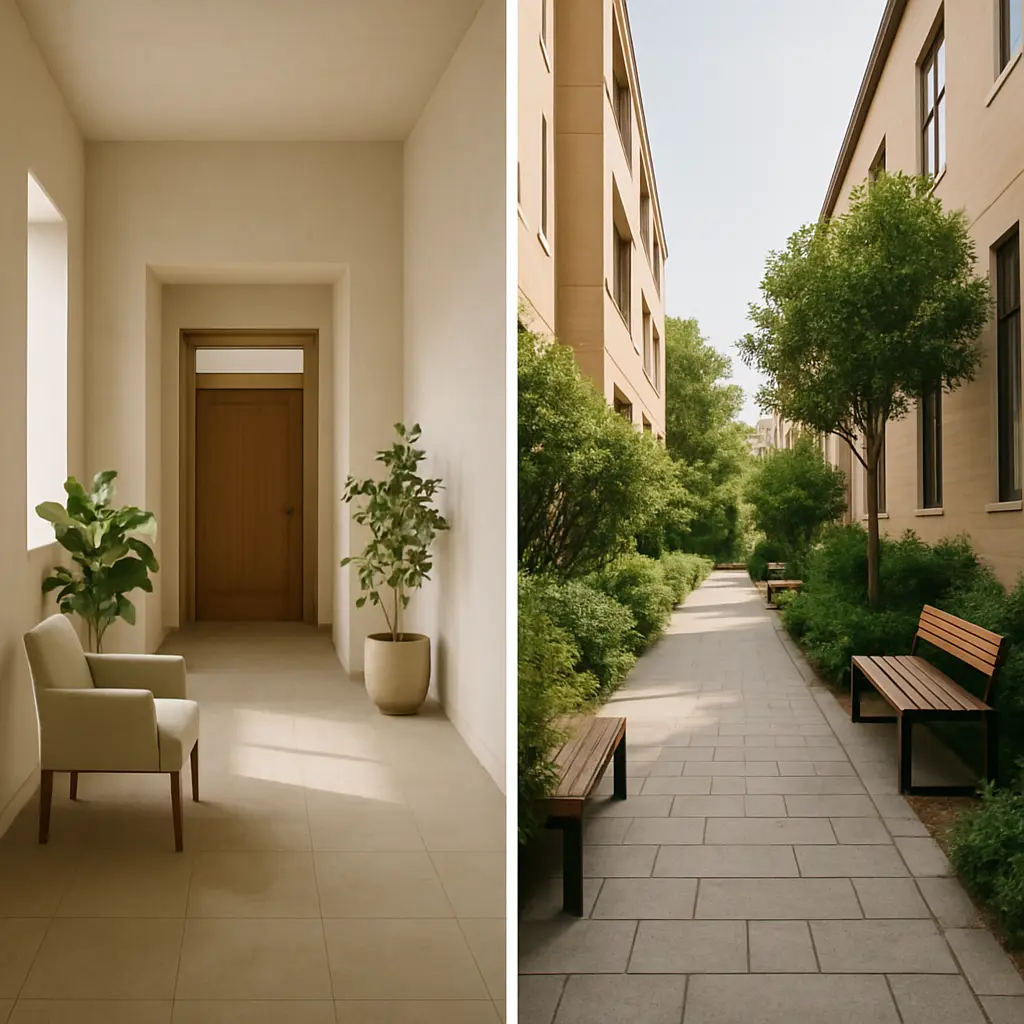With years of design expertise, I’ve learned that a well-placed pause can transform a space. At Curvspace, we celebrate the fleeting moments between major areas. This article examines how crafting in-between time creates opportunities for reflection and mental rejuvenation.
In today’s fast-paced world, the concept of “moments of pause” has gained significant traction in design and architecture. These intentional pauses, often manifested as transitional or in-between spaces, provide opportunities for reflection, mental rejuvenation, and a heightened sense of well-being. At Curvspace, we recognize the importance of these often-overlooked areas and aim to explore how they can be intentionally designed to enhance our daily lives.
Jump to:
The Essence of In-Between Design
In-between spaces, also known as transitional spaces, serve as the connective tissue that harmoniously links distinct functional zones within a structure. They are designed to generate a sense of anticipation, gradually unveiling new vistas and functions as people move through them. These spaces are unassigned areas that belong to everyone and no one, encouraging spontaneity and chance encounters.
The goal is to offer individuals more choices over where they work and how they use their environment, acknowledging that different tasks necessitate different types of spaces. These areas facilitate a smooth and harmonious transition between different surroundings, contributing to the emotional and psychological journey of the users.
Restorative Design: A Foundation for Calm Spaces
Restorative design is a design philosophy that prioritizes creating environments that actively contribute to occupant health and well-being. Rooted in scientific understanding of human psychology and neuroscience, this approach aims to create spaces that support mental and physical well-being through deliberate design choices.
Restorative environments can lead to reduced cortisol levels and lower stress responses, improved attention and cognitive performance, enhanced creativity and problem-solving abilities, better emotional regulation and mood stability, and increased feelings of vitality and well-being. These benefits arise from the environment’s ability to provide “soft fascination,” elements that capture attention gently without demanding concentrated focus, allowing the mind to replenish and improve cognitive function while reducing mental fatigue.
Key Elements of Restorative In-Between Spaces
Several key elements contribute to the restorative potential of in-between spaces:
- Natural Light and Views: Exposure to natural light helps regulate circadian rhythms and boost mood, while views of nature provide opportunities for mental restoration.
- Acoustic Comfort: Managing sound levels and quality helps reduce cognitive load and create conditions conducive to restoration.
- Spatial Organization: Thoughtful layout can create a sense of refuge while maintaining connection to larger spaces, supporting both privacy and engagement.
- Material Selection: The choice of materials can significantly impact both physical and psychological well-being through their texture, color, and environmental impact.
- Optimizing Indoor Environmental Quality: Ensuring clean air, comfortable temperatures, and appropriate humidity levels creates a foundation for restoration.
Designing for Serenity and Simplicity
Creating spaces for serenity and simplicity is essential for promoting mental and physical well-being, improving productivity and creativity, and fostering more sustainable environments. This can be achieved through a minimalist approach, emphasizing natural materials, using lighting strategically, incorporating plants and greenery, and creating a sense of balance.
A minimalist approach to design involves reducing a space to its essential elements, creating a feeling of calm and orderliness. Simple lines, neutral colors, and a limited number of decorative elements can contribute to a more peaceful and uncluttered space. Natural materials such as wood, stone, and natural fibers can create a sense of warmth and tranquility. Soft, diffused lighting, natural light sources, and dimmer switches can help create a serene and calming environment. Plants and greenery improve air quality, reduce noise levels, and create a connection to nature. Symmetrical design elements and a balanced color palette can create a feeling of harmony and calm.

The Art of Creating a Relaxing Environment

In today’s fast-paced world, finding moments of relaxation and tranquility can be a challenge. However, incorporating elements of relaxation into our surroundings is essential for our mental and physical well-being. Soft, muted tones like blues, greens, and earthy neutrals can help create a sense of tranquility and relaxation. Indoor plants reduce stress and improve air quality. Cozy corners or reading nooks provide a space to unwind. Natural materials add warmth and texture, creating a sense of harmony. Minimizing clutter creates a sense of calm and order. Soft, diffused lighting creates a cozy and relaxing atmosphere. Comfortable seating encourages relaxation. Soothing music helps to relax and unwind.
The Power of Pause in Design

The concept of “pause” extends beyond mere physical rest; it encompasses a heightened state of awareness and a connection with something greater than oneself. It involves putting aside the tyranny of the urgent and recalibrating around oneself, giving the time needed to understand one’s best way of being. Pausing connects us back to our purpose, values, and emotions, propelling us to show up authentically and bring our best selves to our lives and work.
I think 99 times and find nothing. I stop thinking, swim in silence, and the truth comes to me.
-Einstein

The Significance of Transition Spaces

Transition spaces play a vital role in shaping the overall experience of a structure. These areas generate a sense of anticipation, gradually unveiling new vistas and functions as people pass through them. Whether it’s a fabulous entrance lobby, a corridor with carefully chosen views, or a transitional garden, these places contribute not just to the physical movement of users, but also to their emotional and psychological journey.
Transition spaces are intended to generate a sense of anticipation, gradually unveiling new vistas and functions as people pass through them. They act as the connective tissue that connects distinct functional zones harmoniously.
Designing for Well-Being
Restorative design creates healthy, connected, and resilient buildings. It envisions a built environment that enhances the well-being of all stakeholders, optimizes economic and climate resilience, and connects us to nature and to each other. It is an intentional process that creates a built environment promoting wellness, economy through conservation, and a more meaningful connection to nature.
Restorative design aims to restore vibrancy and health. It values the way individuals experience the environment, designing buildings to maintain wellness with climatic controls, secure and well-thought-out spaces featuring daylight and fresh air, a relationship with the outdoors, comfortable zones for interaction, and private areas for personal reflection.
People Also Ask
What is the main goal of restorative design?
Restorative design aims to create environments that actively contribute to the mental and physical well-being of occupants by reducing stress, enhancing cognitive function, and promoting overall health.
How do transition spaces contribute to the user experience?
Transition spaces generate a sense of anticipation and provide a smooth transition between different functional zones, contributing to the emotional and psychological journey of the users
What are some key elements of a calm space?
Key elements of a calm space include natural light and views, acoustic comfort, thoughtful spatial organization, mindful material selection, and optimized indoor environmental quality.
Conclusion

Crafting in-between time through intentional design creates opportunities for reflection, rejuvenation, and enhanced well-being. By incorporating elements of restorative design, serenity, and a focus on the human experience, we can transform these often-overlooked spaces into sanctuaries of calm that enrich our daily lives. Contact Curvspace to help you create moments of pause in your environment. Visit our website to learn more.
References
- Friedman, B., & Yoo, D. (2017). Pause: A Multi-lifespan Design Mechanism. Proceedings of the 2017 CHI Conference on Human Factors in Computing Systems. ACM Digital Library.
- Towards Restorative Interior Spaces through Biophilic Design. International Journal of Advanced Research on Planning and Sustainable Development, Vol. 4, Issue 2, 2021, pp. 8–44.
- Architectural Expressions in Designing Transitional Spaces. Re-thinking The Future.
- Travis, M. (2014). Pause. Master’s Thesis, Virginia Polytechnic Institute and State University.
- Designing meaningful moments of pause. SYPartners, Carla Johnson.
- Bae, J., Lim, Y., Bang, J., & Kim, M. (2015). Pause Moment Experience in SNS Communication. Proceedings of the 33rd Annual ACM Conference Extended Abstracts on Human Factors in Computing Systems.
Disclosure
Our content is reader-supported. This means if you click on some of our links, then we may earn a commission. Commissions do not affect our editor’s opinions or evaluations. Learn more about our editorial process.

About the Editorial Staff
The Curvspace editorial team comprises a diverse group of experts on intermediate and threshold spaces in homes and workplaces. Architects and interior designers, civil engineers and artists, environmental and behavioral psychologists, sociologists and anthropologists. All collaborate to create helpful content, that explores the full potential of these often-overlooked areas to enhance our daily lives.


